by Moe | Oct 28, 2013 | History of the Brotherhood, Mystical Christianity
At one time, the religion of Christianity had a different cross as their symbol, than the one used today and over the last 1500-1800 years. The original true cross that the Fathers of the Church had considered a symbol of our Saviour’s cross was the letter Tau, who St. Jerome had declared that the ancient Hebrews before Esdias formed the Tau like a cross, and who Saint Bede had said was “the sign of salvation and of the cross.” The Tau is the 19th letter of the Greek alphabet which is modeled after the Phoenicians who had represented the Tau with the Phoenician letter taw ‘X.’ (more…)
by Moe | Oct 22, 2013 | History of the Brotherhood, Irish History, Meaning of Symbols
The power of the serpent of Egypt was broken on the cross – Justin Martyr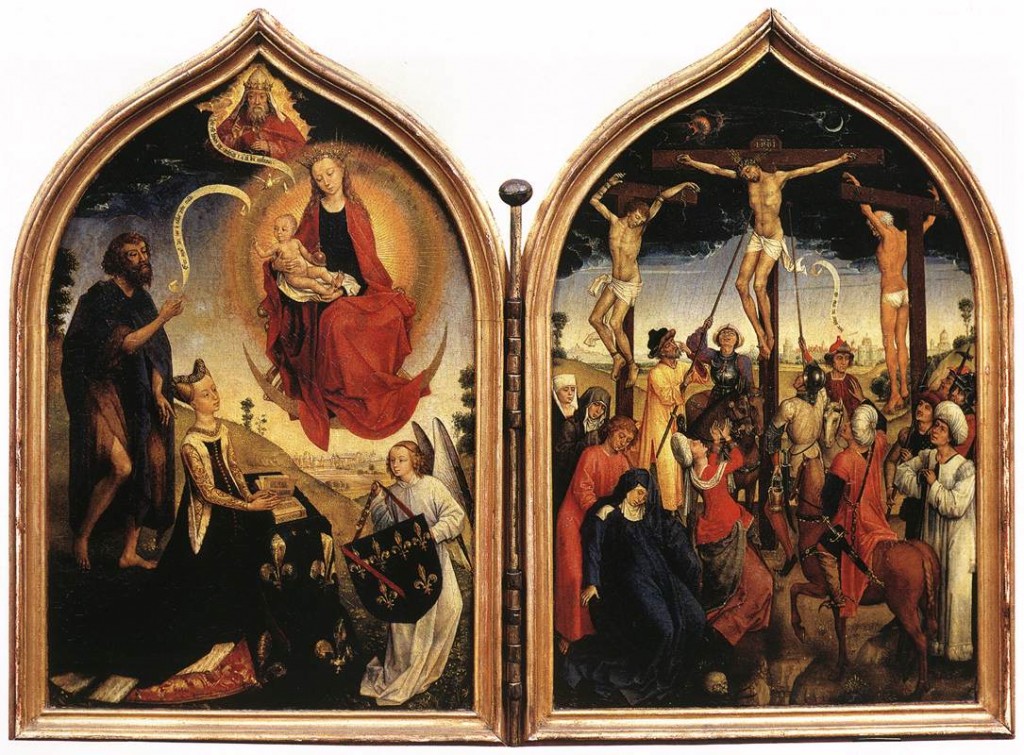
Let it be said, that long before the Romans had given us the images and idols of the Lord and Savior of Jesus crucified upon the cross, the serpent or snake was the chosen image by the ancient wise people of the not so distant past as their savior. In fact, the ancient Romans had used to carry forth the serpent in war, and one of their standards was the serpent on a pole. St. Augustine tells us, that the image of Christ and his Cross was the new ensign of Christian Warfare that the Romans had carried before them; being the Ensign or Profession of their Warfare. Hence as Jesus had said, “I come not to bring peace, but to bring a sword” (Matthew 10:34)
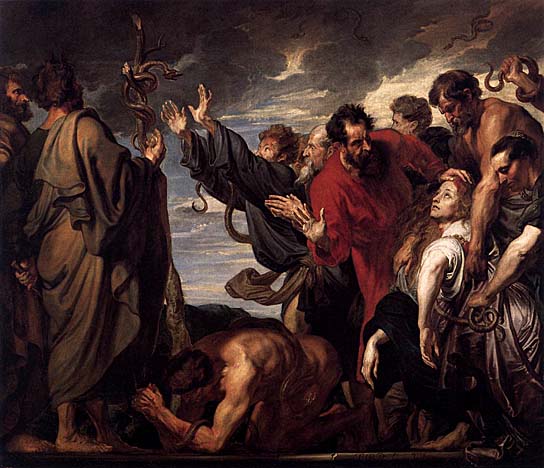 The ancient serpent-god of the Gnostics from the East was Serapis. The various spellings of the name Serapis are, Sor-apis (Σέραπις, Attic/Ionian Greek), Sarapis (Σάραπις, Dorian Greek), Serapin (Greek Ὄφις), or in Hebrew, Seraph. All these names mean ‘serpent.’ The name ‘seraphim’, is the plural form of serpent and is also said to mean, “the burning ones.” Serapis is the Hellenized version of the Egyptian Osiris-Apis.
The ancient serpent-god of the Gnostics from the East was Serapis. The various spellings of the name Serapis are, Sor-apis (Σέραπις, Attic/Ionian Greek), Sarapis (Σάραπις, Dorian Greek), Serapin (Greek Ὄφις), or in Hebrew, Seraph. All these names mean ‘serpent.’ The name ‘seraphim’, is the plural form of serpent and is also said to mean, “the burning ones.” Serapis is the Hellenized version of the Egyptian Osiris-Apis.
“Be ye wise as serpents”
Serapis is the serpent on the cross that was also the precursor to the Christian Christ, who would take the serpents place upon the cross in this Sixth Age under the religion of Christianity. Before the Christian era, the most ancient worship of the serpent was practiced in many areas of the world. The serpent on the cross was still worshiped up to the 7th century in England under the Druids. Tacitus, the Roman senator and historian had said, that Serapis was worshipped as a type of universal deity that represented Jupiter, Osiris, Pluto, and sometimes Jupiter Ammon. The cult of Serapis had originated from the Greco-Egyptian priesthood under the Ptolemies, and the testimony of Pausanias says the temples of Serapis were the most famous at Alexandria, and the most ancient at Memphis.
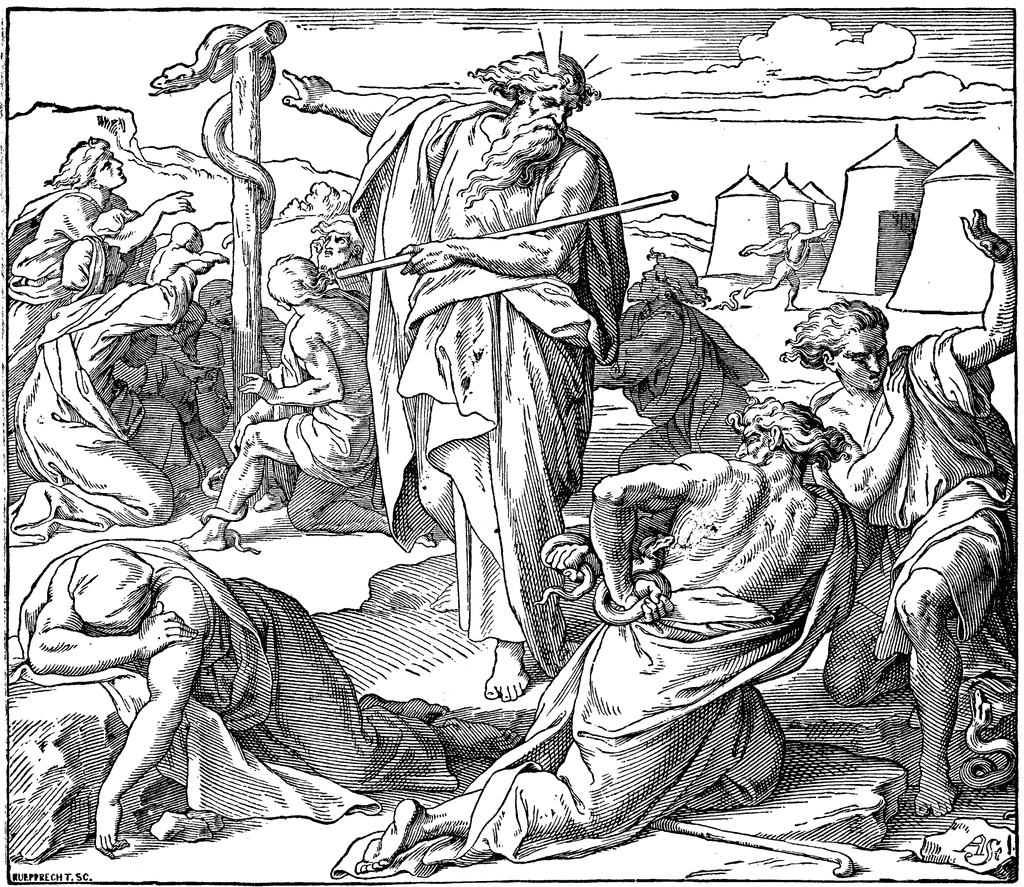 With the symbol of Jesus, St Mark informs us, “With the form of a serpent, He kills the serpent, for the serpent made out of the rod swallowed up the other serpents.” This symbolic event is further explained in St Augustine’s sixth sermon where he said, ” the serpent signifies death, and that Moses’ rod was changed into the serpent because our Lord took upon himself death for us.”
With the symbol of Jesus, St Mark informs us, “With the form of a serpent, He kills the serpent, for the serpent made out of the rod swallowed up the other serpents.” This symbolic event is further explained in St Augustine’s sixth sermon where he said, ” the serpent signifies death, and that Moses’ rod was changed into the serpent because our Lord took upon himself death for us.”
Prior to the 15th century A.D., most people were unlearned and they could neither read or write. The main educated class were usually those fortunate souls who were born into current ruling royal stock. This is why symbols and picture were often the preferred method in which the priesthood and government would educate the people about their religion, gods and history. The Father of English History and Doctor of the Church, Saint Bede who had lived during the 7th century and at the time of this transition from the Old Testament serpent on the cross, to New Testament Jesus on the cross; calls these images, “executed with wonderful art and wisdom.
Some bishops of the church had disagreed with this symbolic method of idolatry type education, such as when the Bishop of Marseilles; Serenus had broken these idols. In the book, “An English-Saxon Homily on the Birth-day of St. Gregory,” By Aelfric (Abbot of Eynsham), he relates the story of Gregory the Great who had declared in his Epistle to Serenus, speaking of those Images which that Bishop had broken;
who know not Letters , may at least be able to read, by looking upon the Walls, what they are not capable of reading in Books. Wherefore, your Brotherhood you’d both preserve them, and hinder the People from adoring them. That sa f1 those who cannot read, may have, from whence to gather some Knowledge of History: And the people be, by no means, permitted to Sin, by the Adoration of a Picture.
Bede had further explained, “A Cross of Silver, and the Image of our Saviour in a Picture. ‘In this manner, Augustine and his Followers are described by Bede, to have come into the Presence of King Æthelbert. They bore a Cross for their Banner, Pro Vexillo: hon pro Adoratione, not for Adoration.” A Latin phrase meaning, “As standards: no honors for Adoration.” Hence, there was no homage or worship given to it, but only as St Augustine had said, “his Cross was the new ensign of Christian Warfare.”
But that you may under« sand the Use of the Images of Stints, and of our “Saviour, which our Saxon Ancestors, and who, writing of the Images of things in Solomon’s Temple, expressed himself thus, If it was lawful to lift up the brazen Serpent upon a Pole, which the Children of Israel beholding, were saved alive: why may we net, by a picture, bring into the Memory of the A Faithfuls that sifting up of our Saviour upon the Cross, by which he overcame Death: or those “his other Miracles, and Cures, by which he wonderfully triumphed over the fame Author of Death Since the fight of these things make oftentimes a deep Impression on the Minds of the Beholders, and to those who are ignorant of Letters, open asit were a kind of lively reading, of the History of our Lord. For picture, in the Greek, is called “(secret for you to find out)”, that is, a writing that expresses the Life.
WHAT IS THE MEANING OF SERPENT WORSHIP AND THE SERPENT ON THE CROSS ?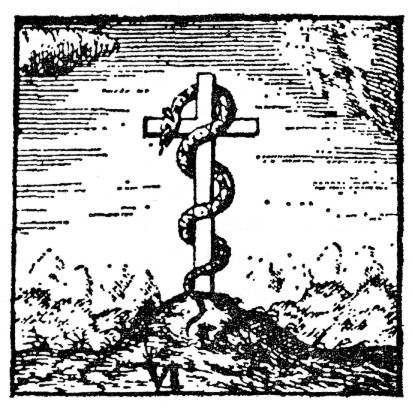
For thousands of years, the serpent or dragon was worshiped by many cultures all around the world. To these ancient people, the serpent had signified wisdom, intelligence, life and rebirth. In a sense, the symbol of the serpent represented Gnosis in the highest sense, which would equate to human godlike status and the equivalent of a Christ or the messiah. However, to modern Christians, the serpent is the devil incarnated and the followers of this ancient wisdom are called Demons. Hence, the 2, 000 year old war between the new savior, Jesus who was the Roman-Jewish messiah of the New Testament (New Law), and the serpent savior who is the prince of Demons of the Greek Old Testament (Old Law).
As Saint John had magically said, “The great dragon was hurled down—that ancient serpent called the devil, or Satan, who leads the whole world astray. He was hurled to the earth, and his angels with him.” – Revelation 12:9
In ancient Greece, the Greatest of all Serpents and the Prince of Good Demons (Angels) was Ophis (Οφιων, Ophiôn, Ophion who had reigned on Mount Olympus with his consort Eurynome). The name Ophis, is Greek for serpent. Author and occultist, HP Blavatsky had written in Isis Unveiled, that the Greeks called Apollo also by the name of Python, which is rendered the same as Ophis, Opis, Oupis, and Oub. Both, Apollo and Ophis were the sons of Zeus who is father of the Gods, father of men, the god of light, truth and prophecy, healing, plague, music, poetry, and more. The followers of Ophis were called the Ophites. Ophis is the Greek equivalent to the ancient Egyptian Apap or Aph-ophis, the Great Serpent who later became Apis, or Epaphus, the Sacred Bull of Egypt. Blavatsky had written, that Apollo and Python, Osiris and Typhon, Christos and the Serpent, are all convertible terms and the followers of this cult that were called Masters of Wisdom, and all Initiates into the Sacred Mysteries, are called Nagas, or Serpents of Wisdom. However, I disagree that Typhon would be considered the same as Apollo, Python, or Osiris.
From the Nile in Egypt, the African plains of Ethiopia, the deserts of Arabia, the highlands of Persia, to the plains of Syria, and to the Phoenicians or Greeks of the Mediterranean Sea and their Holy Island of Crete, to the their biblical tribes of Canaan, the land of Scotia, Ireland, Brittain and to the island of the Culdee Druids in Iona; the ancient priesthoods of these people had always venerated the serpent. One of the symbols of both, Hercules and the Celtic Druid Hu was a serpent.
WHAT HAPPENED TO THE SERPENT ON A POLE?
It wasn’t the Jews who had actually symbolically crucified Jesus to the cross at Golgatha (Place of the skull), but Roman soldiers. St. John tells us clearly, that it was the Jews who had cried out “Crucify Him,” and the soldiers who were Roman that executed the orders of the sentence of death. The Jews would be the instigators, and the Romans the executors, which makes them both accomplices.
What had occurred at this time was simple as I had written above. “With the form of a serpent He kills the serpent, for the serpent made out of the rod swallowed up the other serpents.”
Over time, the Romans who were often at war with these various serpent tribes, had realized that in order to subjugate the world, they had to perform magic and rites that would counter attack the religious rites of the people they had wished to conquer. The main tactical magical method they would employ against these people of the serpent, would be to replace or rename their Gods which they would take ownership of under new names and also reverse symbology, and iconography in which Rome’s chosen Caesar’s, martyred Saints and gods would usurp all other old serpent Gods and demons of the Old Testament.
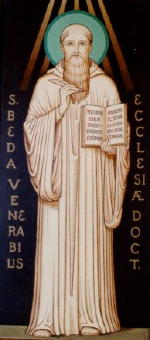 An example of these methods are related to us by the Father of English History and Doctor of the Church, Saint Bede who had lived during the 7th century; in his book, “The Lives of the Abbots of Wearmouth.” Bede tells the story, of how Saint Benedict, in the same time period had made his ‘6th’ and final trip to Rome in order to bring back relics and decorations to Northumbria in Monkwearmouth-Jarrow, for the newly built monasteries of St. Peter and St. Paul which was the main center of Anglo-Saxon learning. The purpose of these relics and art, was to show to people who had visited the monasteries concordance between the Old and New Testaments, how this change from the serpent of Moses to Jesus on the cross as a symbol of Christianity was passed down to us.
An example of these methods are related to us by the Father of English History and Doctor of the Church, Saint Bede who had lived during the 7th century; in his book, “The Lives of the Abbots of Wearmouth.” Bede tells the story, of how Saint Benedict, in the same time period had made his ‘6th’ and final trip to Rome in order to bring back relics and decorations to Northumbria in Monkwearmouth-Jarrow, for the newly built monasteries of St. Peter and St. Paul which was the main center of Anglo-Saxon learning. The purpose of these relics and art, was to show to people who had visited the monasteries concordance between the Old and New Testaments, how this change from the serpent of Moses to Jesus on the cross as a symbol of Christianity was passed down to us.
Soon after the appointment of Easterwine to the abbacy of St. Peter’s, and of Ceolfrid to the direction of St. Paul’s, Benedict had undertaken, and with his wonted prosperity accomplished his sixth and last journey to the city of Rome. Thence he now returned, laden as formerly with a store of ecclesiastical treasures. These, as usual, consisted of a bountiful provision of sacred writings, and an elegant collection of holy pictures. For he brought home on this occasion, the life of our Lord Jesus Christ, described in one series of paintings, with which he beautified the whole interior of the church annexed to the greater monastery, in honour of the virgin mother of God.
For the decoration also of St. Paul’s church and abbey he had procured another set, in which, upon an admirable system, was displayed the concordance between the Old and New Testaments. Of this, to give an instance: Isaac carrying the wood whereon he was ordered to be immolated, and Jesus bearing the cross, on which he died a sacrifice for our sins, are drawn in one piece, and exhibited as corresponding subjects; in a second are paired together, the Son of Man hanging on the cross, and the brazen serpent raised by Moses in the desert.
According to Greek Mythology, eventually the Good Serpent Ophis would be dethroned by his grandfather, the God of chaos 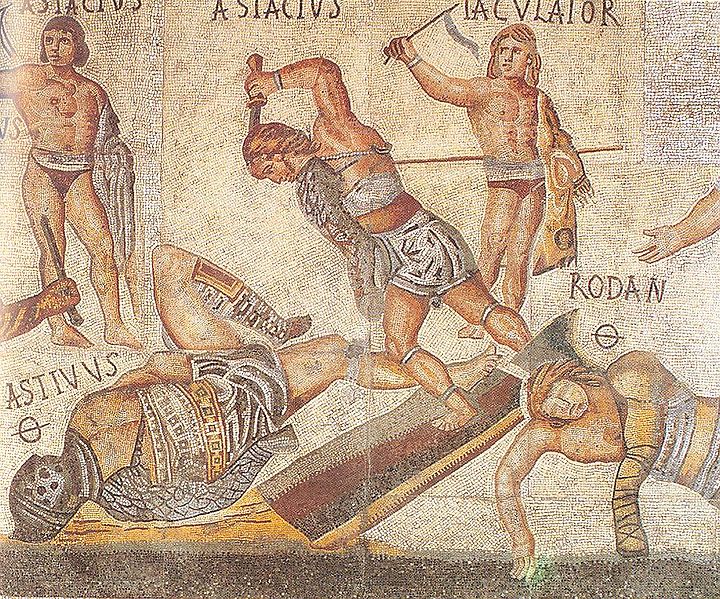 and darkness, Kronos (Saturn or Satan) and the goddess of fertility and war, Rhea (Saturn’s Moon). Hence, the true serpent and dragon of wisdom, Ophis was cast out, and in his place, chaos and darkness would rule under Cronus (Saturn or Satan) and the goddess of fertility and war, Rhea (Saturn’s Moon). This is the reason why, Jesus on the cross is considered by the Fathers of the church, as the standard of Christian warfare and the lower case Greek t, the symbol of death.
and darkness, Kronos (Saturn or Satan) and the goddess of fertility and war, Rhea (Saturn’s Moon). Hence, the true serpent and dragon of wisdom, Ophis was cast out, and in his place, chaos and darkness would rule under Cronus (Saturn or Satan) and the goddess of fertility and war, Rhea (Saturn’s Moon). This is the reason why, Jesus on the cross is considered by the Fathers of the church, as the standard of Christian warfare and the lower case Greek t, the symbol of death.
Based on the testimony of Bede, we can safely date the change of the symbolism, from the Old Testament serpent on the cross, to the son of man, Jesus on the cross for the Anglo-Saxons; it had occurred around the time of Bede in the 7th century, where it had first started in Rome and then later moved to the Anglo-Saxon territories such as Great Britain, England, France, Germany and Spain.
by Moe | Oct 17, 2013 | Apocalypse, History of the Brotherhood
The Apostle John (4 BC – 100 AD) is said to have been born in the city of Ephesus. There are mentioned to be actual records of 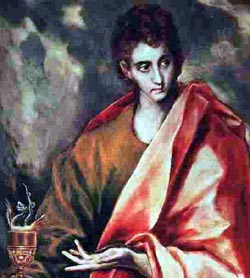 John being arrested by the Emperor Domitian (reigned 81 -96 AD), and then being sent to the small island of Patmos where he had written the Book of Revelation. He was eventually released late in his life of exile from his prison on Patmos, and then returned back to his birthplace of Ephesus where he would convert many Jews to Christianity before his death. Saint John was also buried at Ephesus. A place, that I believe the original city was located on the Holy Island of Crete in the Mediterranean Sea.
John being arrested by the Emperor Domitian (reigned 81 -96 AD), and then being sent to the small island of Patmos where he had written the Book of Revelation. He was eventually released late in his life of exile from his prison on Patmos, and then returned back to his birthplace of Ephesus where he would convert many Jews to Christianity before his death. Saint John was also buried at Ephesus. A place, that I believe the original city was located on the Holy Island of Crete in the Mediterranean Sea.
Today, the city of Ephesus is located in the Selçuk, İzmir Province, Turkey, but I have found that the original ancient city mentioned in the bible was actually on the island of Crete. It simply appears to me, that many of these very old cities were moved or were sister cities created, and that were models of the original ancient cities. This can be easily researched to connect the dots, by anyone who wishes to verify my words that I write in this article with the links to the sources that I provide.
in the early history of the Church, from St. John’s having been banished to it, and having there written his Apocalypse. The modem name is Patmo. 3. Liros lay to the southeast of Patmos. It was peopled from Miletus, and probably belonged to that city. Strabo gives its inhabitants a character for dishonesty. The modern name is Lero. 3. Calymna lay to the southeast of Leros. Ovid praises its honey. It is supposed to have belonged to the group which Homer calls Calydna. The modern name is Ctrfimno. 4. Cos, to the southeast, an island of some celebrity. It must have been inhabited at an early period, since Homer represents it as sending its warriors to the siege of Troy. It was subsequently colonized by a party of Dorians, and hence was always reckoned of Dorian origin, and obtained a place in the Triopian Pentapolis. Its chief city was also called Cos, without the walls of which was a celebrated temple of .Esculapius, containing two famous paintings of Apelles, the Antigonus and Venus Anadyomene. Augustus removed the latter to Rome, and remitted to the Coans, as a compensation for the loss, a tribute of one hundred talents. Cos was the birth-place not only of Apelles, but also of the celebrated physician Hippocrates. It was a very productive island, especially in wine, which vied with that of Lesbos and Chios. Cos was likewise celebrated for its purple dye, and for its manufacture of a species of transparent silk stuff, against the use of which by the Romans Juvenal so strongly inveighs. The modern name of the island is Stan-Co (A System of Ancient and Mediæval Geography for the Use of Schools and Colleges
By Charles Antho)
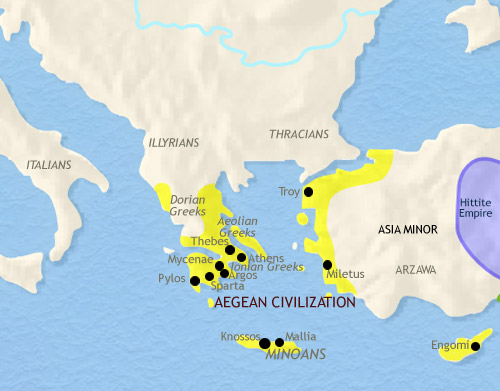 There are many connections and clues tying the City of Ephesus to being located on Crete.
There are many connections and clues tying the City of Ephesus to being located on Crete.
Besides the city of Ephesus being the birthplace and burial site of Saint John, it was also world-famous for the Temple of Artemis (completed around 550 BC). In Greek mythology, Artemis, who was also called Letois was the daughter of the Father of the Gods, Zeus (Jupiter); her mother was the Titan, Leto who was the goddess of motherhood, and with her children, a protectress of the young. Her brother was the God of Healing, Apollo.
In Crete, at the city of Dreros, Spyridon Marinatos uncovered an eighth-century post-Minoan hearth house temple, in which there were found three unique figures of Apollo, Artemis and Leto made of brass sheeting hammered over a shaped core (sphyrelata).
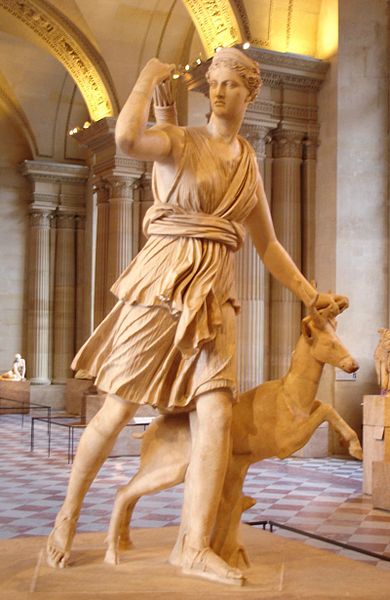 Homer refers to her as Artemis Agrotera, Potnia Theron: “Artemis of the wildland, Mistress of Animals.” The Arcadians believed she was the daughter of Demeter. She was also the protector and goddess of young men and or priesthood who were called the Curetes (Kuretes or Kouretes). The worship of Artemis had originated in Minoan Crete, where she was “goddess of mountains and hunting’, who was the “sweet maiden’ and “sweet virgin,” Britomartis (Βριτόμαρτις).
Homer refers to her as Artemis Agrotera, Potnia Theron: “Artemis of the wildland, Mistress of Animals.” The Arcadians believed she was the daughter of Demeter. She was also the protector and goddess of young men and or priesthood who were called the Curetes (Kuretes or Kouretes). The worship of Artemis had originated in Minoan Crete, where she was “goddess of mountains and hunting’, who was the “sweet maiden’ and “sweet virgin,” Britomartis (Βριτόμαρτις).
Strabo notes she was venerated as Diktynna, only in western Crete in the region of Cydonia, where there was a Diktynnaion , or temple of Diktynna. “Oupis [Artemis], O queen, fairfaced Bringer of Light, thee too the Kretans name after that Nymph,” Callimachus says. “She passed her time in the company of Artemis, this being the reason why some men think Diktynna and Artemis are one and the same goddess,” Diodorus Siculus (5.76.3) suggested.
By Hellenistic and Roman times, Britomartis was given a genealogical setting that fitted her into a Classical context: “Britomartis, who is also called Diktynna, the myths relate, was born at Kaino in Crete of Zeus and Karme,[8] the daughter of Euboulos who was the son of Demeter; she invented the nets [diktya] which are used in hunting.”
The reason I relate these stories to you, is for reference to Greek mythology and is because this all takes place on the island of Crete. In addition, one of the best authorities on the subject would be Strabo who was a native from Crete. Hence, it only makes sense, that if Zeus was born on Crete and the legend has it that he was hidden in a cave on Mount Ida on the same island where he would father other Gods and Goddesses such as Artemis and Apollo, that these temples and the main home for them would be on the same holy land. It was only after the Romans had taken over Crete and the religion of the Greek Jews, that they would then change many of the names of these goddesses and Gods; where Artemis then, became known as “Diana of Ephesus” and her Temple from then on was called, “The Temple of Diana.”
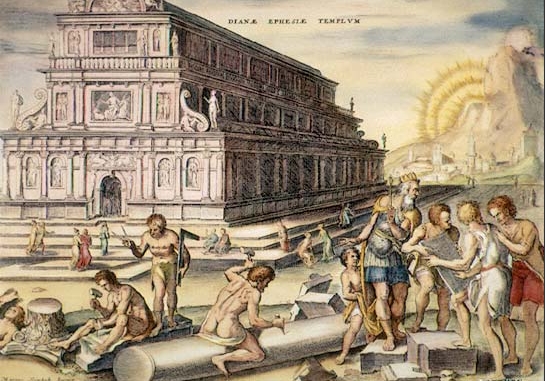 The Temple of Artemis (Diana) was one of the Seven Wonders of the Ancient World. In the 7th century BC, the old temple was destroyed by a flood. Its reconstruction began around 550 BC. under the Cretan architect Chersiphron and his son Metagenes, at the expense of Croesus of Lydia: the project took 10 years to complete, only to be destroyed in an act of arson by Herostratus. It was later rebuilt in 268 AD., and the Temple was destroyed or damaged yet again in a raid by the Goths. In Greek and Roman historical tradition, the temple’s destruction coincided with the birth of Alexander the Great (around 20/21 July 356 BC). Plutarch remarked, that Artemis was too preoccupied with Alexander’s delivery to save her burning temple. (Wikpedia)
The Temple of Artemis (Diana) was one of the Seven Wonders of the Ancient World. In the 7th century BC, the old temple was destroyed by a flood. Its reconstruction began around 550 BC. under the Cretan architect Chersiphron and his son Metagenes, at the expense of Croesus of Lydia: the project took 10 years to complete, only to be destroyed in an act of arson by Herostratus. It was later rebuilt in 268 AD., and the Temple was destroyed or damaged yet again in a raid by the Goths. In Greek and Roman historical tradition, the temple’s destruction coincided with the birth of Alexander the Great (around 20/21 July 356 BC). Plutarch remarked, that Artemis was too preoccupied with Alexander’s delivery to save her burning temple. (Wikpedia)
Antipater of Sidon of Crete from around 140 BC, had named six of the seven sites on his list—leaving out the lighthouse—, but was primarily in praise of the Temple of Artemis at Ephesus:
I have gazed on the walls of impregnable Babylon along which chariots may race, and on the Zeus by the banks of the Alpheus, I have seen the hanging gardens, and the Colossus of the Helios, the great man-made mountains of the lofty pyramids, and the gigantic tomb of Mausolus; but when I saw the sacred house of Artemis that towers to the clouds, the others were placed in the shade, for the sun himself has never looked upon its equal outside Olympus.
— Greek Anthology IX.58
St. John had opposed a man in Ephesus named ‘Cerinthus,’ who was a Jewish Christian and the alleged Gnostic arch-heretic. Ephesus was one of the seven churches of Asia that are cited in the Book of Revelation. Hence, it was one of the most important religious centers of all the world at the time, and it would continue to be for many centuries, even after it was conquered by the Romans. The story of St. John, the Gnostic Cerinthus and his followers, I will write on in the near future.
Christianity in the city of Ephesus, was introduced in the 1st century AD by Paul the Apostle who visited Ephesus around 53 AD, where he spent three months teaching in a synagogue in an effort to bring the Greek Jews to accept union with the gentiles of Rome in Christianity, but he met with little success. For the next two years he stayed in Ephesus on Crete, where he appears to have made many converts.
One of his Gentile converts was actually a Roman Emperor by the name, Titus who would later become the companion of Paul 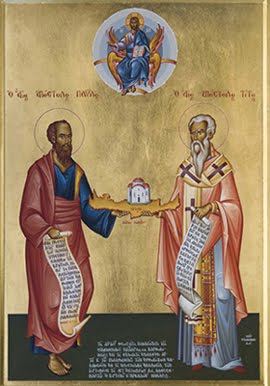 who had appointed him Bishop of Crete after the siege of the City of Jerusalem and the destruction of the Temple. Hence, the Roman Emperor Titus became master of the island of Crete after he had conquered the government and religion, where he then would be immortalized in the Catholic Church as Saint Titus forever thereafter.
who had appointed him Bishop of Crete after the siege of the City of Jerusalem and the destruction of the Temple. Hence, the Roman Emperor Titus became master of the island of Crete after he had conquered the government and religion, where he then would be immortalized in the Catholic Church as Saint Titus forever thereafter.
Titus 1:5-9 – I (Paul) left you (Titus as minister) in Crete to set right matters which needed attention, and gave you instructions to appoint elders in every city. They were to be men of unquestioned integrity with only one wife, and with children brought up as Christians and not likely to be accused of loose living or law-breaking. To exercise spiritual oversight a man must be of unimpeachable virtue, for he is God’s agent in the affairs of his household. He must not be aggressive or hot-tempered or over-fond of wine; nor must he be violent or greedy for financial gain. On the contrary, he must be hospitable, a genuine lover of what is good, a man who is discreet, fair-minded, holy and self-controlled: a man who takes his stand on the orthodox faith, so that he can by sound teaching both stimulate faith and confute opposition.
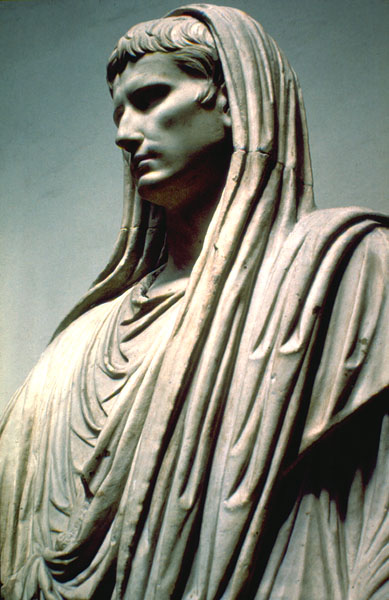 When Augustus Caesar became Roman Emperor in 27 BC, he made Ephesus the capital of proconsular Asia (which covered western Asia Minor) instead of Pergamum. He had built a city to his name nearby Ephesus called, Caesaria, which at the time of Paul was the seat of where, the then governor of Idaea or Judea (Tribe of Judah) had resided. The Cretans were called back then, the ‘Idaeans’ and according to Homer, one of their rulers was known as ‘Idomensus,’ the grandson of the ruler of Knossos. The children of Idomensus were, whom Homer had called the royal and warlike ‘Idomen,‘ and who we would know of today as the Judeans (Idaeans, Tribe of Judah). Ephesus then entered an era of prosperity, becoming both the seat of the governor and a major center of commerce.
When Augustus Caesar became Roman Emperor in 27 BC, he made Ephesus the capital of proconsular Asia (which covered western Asia Minor) instead of Pergamum. He had built a city to his name nearby Ephesus called, Caesaria, which at the time of Paul was the seat of where, the then governor of Idaea or Judea (Tribe of Judah) had resided. The Cretans were called back then, the ‘Idaeans’ and according to Homer, one of their rulers was known as ‘Idomensus,’ the grandson of the ruler of Knossos. The children of Idomensus were, whom Homer had called the royal and warlike ‘Idomen,‘ and who we would know of today as the Judeans (Idaeans, Tribe of Judah). Ephesus then entered an era of prosperity, becoming both the seat of the governor and a major center of commerce.
According to Strabo, the city of Ephesus was second in importance and size only to Rome.
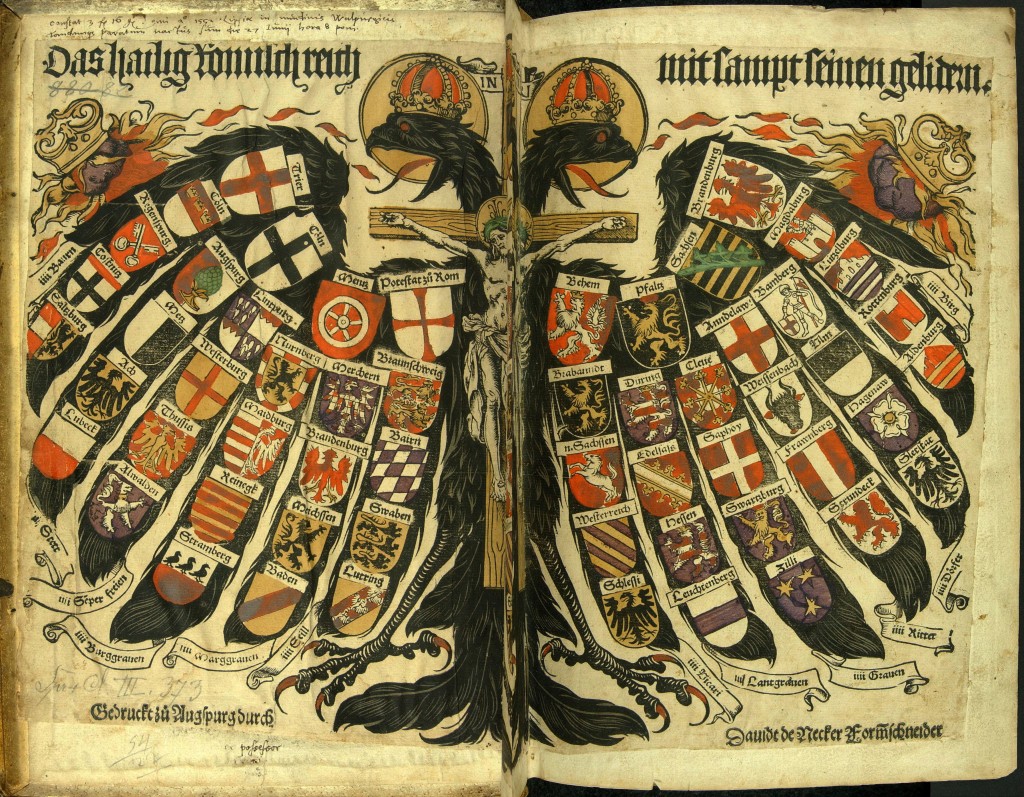
MORE FACTS CONNECTING SAINT JOHN AND THE CITY OF EPHESUS TO CRETE (Open Source)
Two decades later, the church at Ephesus was still important enough to be addressed by a letter written by Bishop Ignatius of Antioch to the Ephesians in the early 2nd century AD, that begins with, “Ignatius, who is also called Theophorus, to the Church which is at Ephesus, in Asia, deservedly most happy, being blessed in the greatness and fullness of God the Father, and predestinated before the beginning of time, that it should be always for an enduring and unchangeable glory” (Letter to the Ephesians). The church at Ephesus had given their support for Ignatius, who was taken to Rome for execution.
A legend, which was first mentioned by Epiphanius of Salamis in the 4th century AD, purported that Mary may have spent the last years of her life in Ephesus. The Ephesians derived the argument from John’s presence in the city, and Jesus’ instructions to John to take care of Mary after his death. Epiphanius, however, was keen to point out that, while the Bible says John was leaving for Asia, it specifically does not say that Mary went with him. He later stated that she was buried in Jerusalem.
In the 3rd century, the emperor Constantine I rebuilt much of the city of Ephesus, and erected a new public bath. Constantine the Great frequently traveled to Nicomedia in Crete near Ephesus and had made this city his place of residence. He later died near his home in the year 337.’ Ephesus remained the most important city of the Byzantine Empire in Asia after Constantinople in the 5th and 6th centuries.
by Moe | Oct 15, 2013 | Gods & Goddesses, History of the Brotherhood
“The Great Dragon was cast out, that Archaic Ophis, called Diabolos and Satan, that deceiveth the whole world.” – HP Blavatsky
Just this past week, Pope Francis had given a sermon in which he had reminded Catholics that the Devil is real and we are called to spiritual warfare. Here is an excerpt and video of this sermon;
There are some priests who, when they read this Gospel passage, this and others say: ‘But, Jesus healed a person with a mental illness’. They do not read this, no? It is true that at that time, they could confuse epilepsy with demonic possession; but it is also true that there was the devil! And we do not have the right to simplify the matter, as if to say: ‘All of these (people) were not possessed; they were mentally ill’. No! The presence of the devil is on the first page of the Bible, and the Bible ends as well with the presence of the devil, with the victory of God over the devil.
Do not confuse the truth. Jesus fights the devil: first criterion. Second criterion: he who is not with Jesus, is against Jesus. There are no attitudes in the middle. Third criterion: vigilance over our hearts because the devil is astute. He is never cast out forever. It will only be so on the last day.
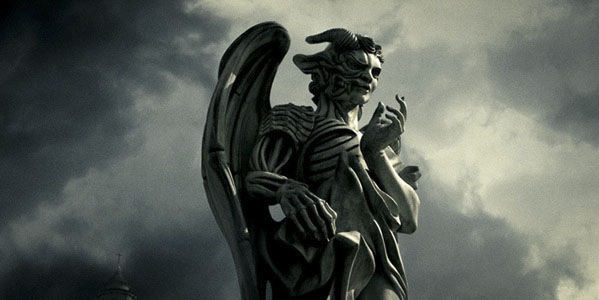 WHO IS THIS DEVIL AND ARE DEMONS REAL?
WHO IS THIS DEVIL AND ARE DEMONS REAL?
“Are they real, or are these papal claims just religious dogmas perpetuated in order to keep fear in the minds of the billion people who are members of the Catholic Church?”
The religious facts, are that the name of the devil has brought fear and mayhem into the minds of the people ever since it has been written and that this head prince of the demons had fallen when he turned his face away from God. To live, is to spell evil backwards and to be a devil, is to spell the word lived backwards. Hence, we live in a world that has been magically turned upside down, where there is a war for your soul here, and the never-ending spiritual warfare for our minds is a reality that many of us chained souls have come to know intimately.
To some people, the Devil is an invented character by the church, just like Jesus, who they say that his teachings were simply part of a secret Roman government plan that was hell-bent on subjugating the people they had conquered and their minds via religious dogmas. To other people who are more educated on these spiritual matters such as the early Church Fathers and some of the world’s best authorities on the occult, the devil and his legions of demons are as real as Jesus and the Pope.
In the Gospel of Luke, he explains who these demons are and who is their prince;
When Jesus had driven out a demon, some of the crowd said: “By the power of Beelzebul, the prince of demons, he drives out demons.” Others, to test him, asked him for a sign from heaven. But he knew their thoughts and said to them, “Every kingdom divided against itself will be laid waste and house will fall against house. And if Satan is divided against himself, how will his kingdom stand? For you say that it is by Beelzebul that I drive out demons. If I, then, drive out demons by Beelzebul, by whom do your own people drive them out? Therefore they will be your judges.
WHO WAS THE GREEK JEWISH DEMON BAALZEBUL THAT CATHOLICS CALL THE DEVIL OR SATAN?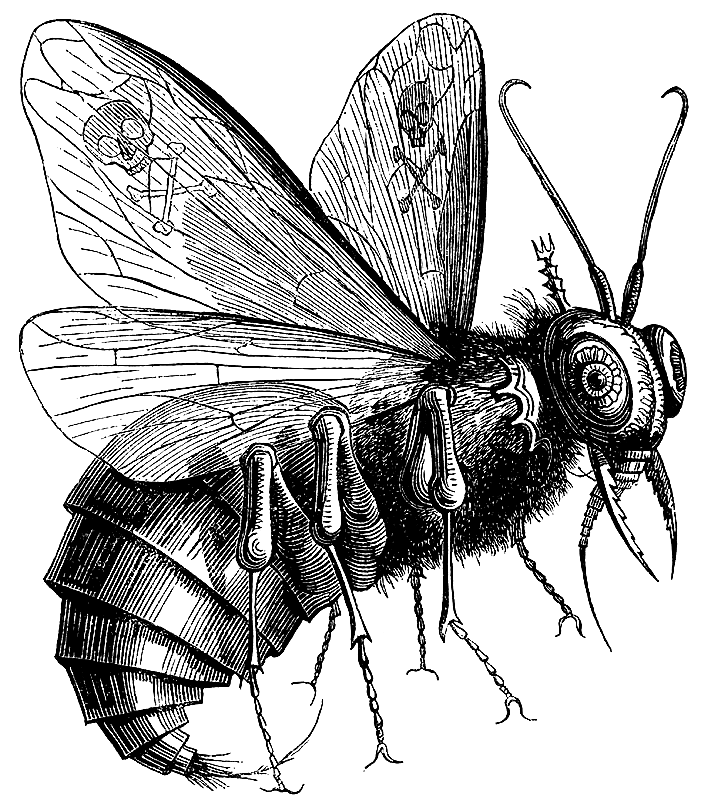
In the cult of Serapis, Beelzebul (Beelzeboul, Beelzebub, Beelsebab, Baalzebub or Ba’al) is prince of the Seraphim, just below Lucifer. The cult of Serapis had originated from the Greco-Egyptian priesthood under the Ptolemies. The testimony of Pausanias, says the temples of Serapis were the most famous at Alexandria, and the most ancient at Memphis. Tacitus, the Roman senator and historian had said that Serapis was worshipped as a type of universal deity that represented Jupiter, Osiris, Pluto, and sometimes Jupiter Ammon.
The name Beelzebul is a corruption of the Phoenician God ‘Ba’al’ (usually pronounced “bail”) and is mentioned in the Old Testament as the pagan idol of the Phoenicians, Ethiopians, Syrians and Greeks who had often worshiped Ba’al in conjunction with the fertility and war-goddess, Ashtaroth. The meaning of the term ‘Baal’, in both Gaelic and in Phoenician is – “the lord of heaven or lord of souls.” The plural of Baal is Baalim, or Baals (Judges 2:11, 10:10). Baalzebub or Beelzebul (bee-EL-ze-bull) is mentioned 2 Kings i, 2, and the name Beelzebul signifies the Lord of the Flies (which originally meant “Lord of everything that flies”), King of the Earth, and the Prince Daimon who is said to be the chief of spirits amongst the Jews.
Since only priests were allowed to utter his divine name, Hadad, Ba‛al was commonly used and few, if any Biblical uses of “Baʿal” refer to Hadad, the lord over the assembly of gods on the holy mount of Heaven. This is evident in the name Baal or Baalzebub becoming the corruption of Beelzebul, that is only found in the bible via the texts of the Acts of Pilate (also known as the Gospel of Nicodemus) and vary in whether they use Beelzebul or Beelzebub. The name is used by Hades as a secondary name for the Devil, but it may vary with each translation of the text; other versions give the name Beelzebub as Beelzebub, but separates him from the devil. The Gospel of Nicodemus is in two sections, with an appendix, Descensus ad Infernos—the Harrowing of Hell—that does not exist in the Greek texts, and is a later addition to the Latin versions. (Wikipedia)
In ancient Syria, the name, King Hadad was known as Adad, or Aden. The name Hadad is also spelled as Eldad, Bedad, Adad, Aden, Dudu, Dawd, Amnidad and Heldan. The meaning of Hadad is “on of Dod or David”, or Be-dad or Bon-dad, “the son of Dad,” and David, Daoud, or Dood means the beloved ; and as a mythical character the beloved one, the Lord’s anointed. The same is seen in the Kings of Edom, in Genesis in the names of ” Hadad,” Bedad ( = Bendad, son of Dod or David), Samlah, Shaul ( = Saul), and Benhanan. In the names Dod, Dad, Dan and David, we have a specific true meaning behind these other names. This true meaning would be “Father.” Hence, when we find these many different names written in literature, they are referring to one “Lord and Father.”
Many Bible scholars translate the name David as Beloved, but the Hebrew root  (dwd) that yields
(dwd) that yields  (dod), meaning beloved in general or uncle more specifically; King David’s most beloved son, Solomon. By the side of King Hadad, stood his son Ben-Hadad. In ancient Syrian, Hebrew and Arabic, Ben means son. It is the kings of Edom (Gen. xxxvi. 35) who were called “Hadad, the son of Bedad,” or Ben-[Ha]dad who are also known to us now as the Priests of Baal, serpents, dragons, wise ones, Giants, and the Nephilim who are the Sons of God that became the fallen ones.
(dod), meaning beloved in general or uncle more specifically; King David’s most beloved son, Solomon. By the side of King Hadad, stood his son Ben-Hadad. In ancient Syrian, Hebrew and Arabic, Ben means son. It is the kings of Edom (Gen. xxxvi. 35) who were called “Hadad, the son of Bedad,” or Ben-[Ha]dad who are also known to us now as the Priests of Baal, serpents, dragons, wise ones, Giants, and the Nephilim who are the Sons of God that became the fallen ones.
Lucifer is another word for the Greek word, Phosphorus (Greek Φωσφόρος Phōsphoros), a name meaning “Light-Bringer” and the Morning Star. Baal, along with Lucifer and Leviathan, were the first three angels to fall, and Baal tempts men with pride and is opposed by St. Francis of Assisi. (Wikipedia) St. Francis was the founder of the Cordeliers and Franciscans. He was also known as the Seraphic Father and Seraphic Saint because of a vision he saw on Mount Alverna where he witnessed a crucified seraph who perforated his feet, hands, and right side. In the New Testament, Baal is identified as the Devil, “prince of the demons” and in Catholic demonology, is one of the seven princes of Hell according to Catholic views on Hell.(Wikipedia)
ARE DEMONS, SERPENTS AND DRAGONS EVIL?
The Greek word daimon does not carry the negative connotation as it does today with Catholics and Christians. This is explained by 33rd Degree Freemason, Master Rosicrucian and author, Manly P. Hall who had written in “The Secret Teachings of all Ages,” that the Christian Church had literally taken these elemental entities or angels and grouped them together under the title of demon, and that for to the average mind the word demon means an evil thing.
The Christian Church gathered all the elemental entities together under the title of demon. This is a misnomer with far-reaching consequences, for to the average mind the word demon means an evil thing, and the Nature spirits are essentially no more malevolent than are the minerals, plants, and animals. Many of the early Church Fathers asserted that they had met and debated with the elementals.
The Serpent was venerated for thousands of years in ancient Egypt, Phoenicia, Ethiopia, Greece and many other places around the world as an emblem of divinity, an oracle, and as a god. The Greeks called Apollo also by the name of Python, which is rendered the same as Ophis, Opis, Oupis, and Oub. Ophis represents divine Wisdom (Blavatsky). Apollo and Ophis were the sons of Zeus who is the god of light and the sun, truth and prophecy, healing, plague, music, poetry, and more. This Serpent-worship or what the church would call devil worship, had continued amongst the Samaritans in the West and in Europe, and with the Druids in Ireland, Scotland and Britain. The Masters of Wisdom, and all Initiates into the Sacred Mysteries are called Nagas, or Serpents of Wisdom . These Gnostic Serpent Priests of Wisdom from the East had went under various names such as the Ophites, and the Hivites who later became known as the Levites; all these names signify serpent. The Ophites were said to attribute all wisdom to the serpent, who was also the author of knowledge to men.
The biblical legend of the serpent is derived from Greek legends where one of the first Titans, Ophis; meaning serpent, and who ruled over Olympus with his queen; Eurynome was dethroned by the God of chaos and darkness, Cronus (Saturn or Satan) and the goddess of fertility and war, Rhea (Saturn’s Moon). In Greek mythology, Olympus was the home of the Twelve Olympian gods of the ancient Greek world. It formed itself after the gods defeated the Titans in the Titan War, and soon the palace was inhabited by the gods.
To the Phoenicians, Ethiopians, Syrians and Greeks who are the Jews of the Old Testament, Baal was their chief daimon (daemon or demon) or simply, their God. Ba’al would be the equivalent to Jesus in the New Testament, but Ba’al is the race or ancestor God of who we call today the Jewish people of the Old Testament and Jesus would be the new chosen son or messiah, Augustus Caesar with his blood to commemorate as the cornerstone of the newly built Roman Empire, and who under Roman and Cannon Law via the new law of the New Testament would abolish all old gods and teachings of the Old Testament.
From this point forward, Ba’al becomes the devil, their angels become evil ugly demons, and the people called the Phoenicians, Ethiopians, Syrians and Greeks, along with their religion become Jews. This spiritual event at the turn of the millenia marks the great dividing point between the Old Law under the Greek Ptolemy’s of the Old Testament and the New Law under the Caesars and Rome. Hence, Rome against the world and old spirit world via Vatican magic of the pen and backed by the sword of the Roman Army.
As I mentioned above, Baal is prince of the Seraphim just below Lucifer. The name ‘seraphim’ is the plural form of serpent and is also said to mean, “the burning ones.” Seraphs appear in the 2nd century BC Book of Enoch, where they are designated as drakones (δράκονες “serpents”) and are mentioned in conjunction with cherubs as the heavenly creatures standing nearest to the throne of God. Serapis is the Hellenized version of the Egyptian Osiris-Apis. The various spellings of the name Serapis are Sor-apis (Σέραπις, Attic/Ionian Greek), Sarapis (Σάραπις, Dorian Greek), Serapin (Greek Ὄφις), or in Hebrew Seraph.
Please also note that the great dragon, devil or diabolos is a drakones (δράκονες “serpent”), and is a heavenly creature standing nearest to the throne of God. All these names mean ‘serpent’ which is the symbol of wisdom, knowledge and Gnosis. Hence, the battle against the serpent or the Great Dragon is the battle of the Roman Church against knowledge and Gnosis.
It is the Old Serpent of the Genesis. Since the church was opposed to the serpent who brought this Gnosis and knowledge to men to make them wise, they had symbolically crucified the prince of the Seraphim, Jesus at Golgotha, the place of the skull, in order for the church to take the place of wisdom and the serpent and in which they would become the vicars of Christ. Therefor, Baal becomes Satan or the Old Serpent under Roman Catholic Church Law via the New Testament. A church that was simply against the religion and angels or Daimons (Demons) of the Ancient Greek Jews who had committed the sins of propagating wisdom and Gnosis, and for good reason.
 But as Pope Francis says, “the devil is astute. He is never cast out forever. It will only be so on the last day.”
But as Pope Francis says, “the devil is astute. He is never cast out forever. It will only be so on the last day.”
Pope Francis and the Devil
“Vigilance, because his strategy is this: ‘You became Christian. Advance in your faith. I will leave you. I will leave you tranquil. But then when you are used to not being so watchful and you feel secure, I will come back’. The Gospel today begins with the devil being cast out and ends with the devil coming back! St. Peter would say: ‘It is like a fierce lion that circles us’. It is like that.”
‘But, Father, you are a little ancient. You are frightening us with these things’. No, not me! It is the Gospel! And these are not lies: it is the Word of the Lord! Let us ask the Lord for the grace to take these things seriously. He came to fight for our salvation. He won against the devil! Please, let us not do business with the devil! He seeks to return home, to take possession of us. Do not relativize; be vigilant! And always with Jesus!”
by Moe | Oct 13, 2013 | Gods & Goddesses, History of the Brotherhood, Uncategorized
The city of Knossos on the island of Crete, Greece has a deep history in helping create modern civilization, that many people 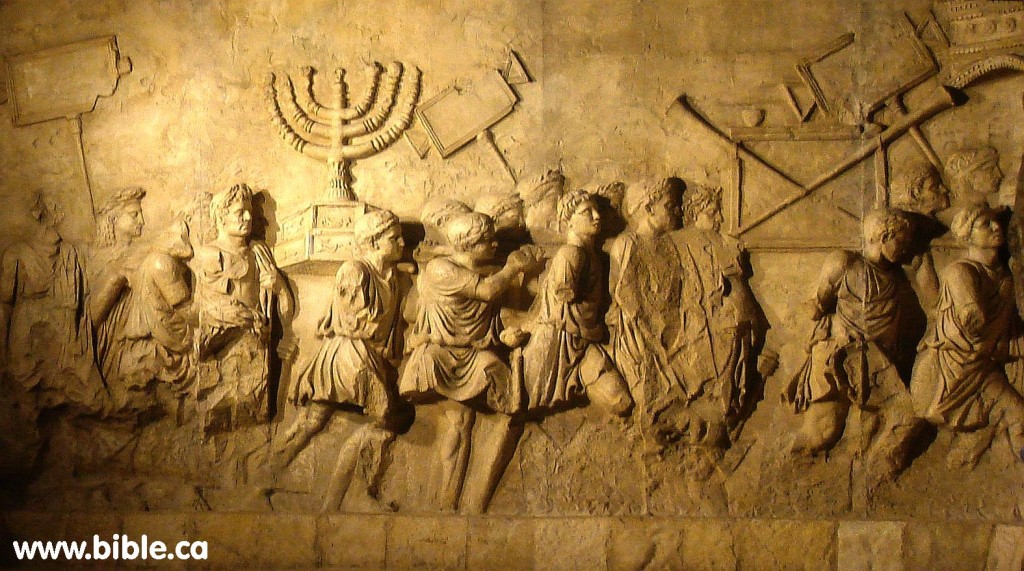 are unaware of. The history I speak of goes back to approximately 1600 B.C. and had flourished until approximately 70 A.D. This is the time when I believe, that their old culture and religion was destroyed in the great Judean rebellion and siege of Jerusalem by the new comers on the world scene and who happened to be their Italian cousins, the Romans.
are unaware of. The history I speak of goes back to approximately 1600 B.C. and had flourished until approximately 70 A.D. This is the time when I believe, that their old culture and religion was destroyed in the great Judean rebellion and siege of Jerusalem by the new comers on the world scene and who happened to be their Italian cousins, the Romans.
The destruction of the ancient Palace Temple (the Second Temple), the royal archives, and the entire city of Knossos had come at the orders of Roman Emperor, Nero who had sent Vespasian and his son Titus to Judea in order to subdue the Jewish nation in a massive invasion of the Holy Island of Crete in the year 67 A.D. Titus had served under his father on the island of Crete in the kingdom of Judaea (Greco-Egypt) during the First Jewish-Roman War. For winning this historic holy battle for the Romans, Titus would later become known as Saint Titus, Bishop of Crete and companion to the Apostle Paul.
The greatest of ancient Greek epic poets, Homer had written in his most famous works, the Iliad and the Odyssey, that the city of Knossos is mentioned along with Phaestos as having magnificent temples. But it is the city of Knossos that he clearly identifies as the most dominant city of a rich and populous land. Homer had called it, “Broad Knossos,” in which he tells us of the maze. In later times, archeologist, Sir Arthur Evans in the late 19th century would excavate the Temple at Knossos and change the name to the Minoans; he called the maze, the Labyrinth of the Minotaur Bull. Homer in the Odyssey sang: “One of the great islands of the world In midsea, in the wine-dark sea, is Crete, spacious and rich and populous.”(Hom. Od. XIX, 172ff). He also mentions, that rituals were held for the goddess Ilythyia in the cave of Amnisos.
Homer describes this period in history as an age that is called the “prehistoric period of Europe.” The Ages of the Old Law under the Old Testament before those of the Roman Catholic Church and the New Testament, in which the new law and religious customs of the 6th Age were born under the leadership of the first Roman Pope, Augustus Caesar. Hence, the law of Caesar. King Lucius, 2nd-century King of the Britons traditionally credited with introducing Christianity into Britain has said, “superior papal authority and dominion is derived from the law of the Caesars.”
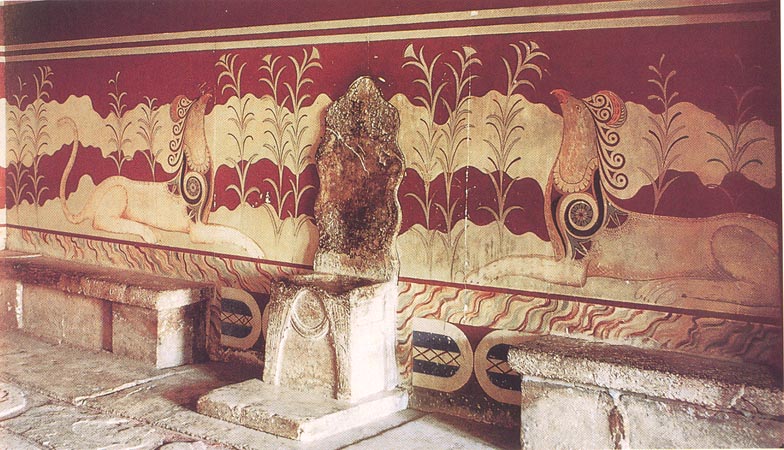 Both the Iliad and the Odyssey were highly venerated ancient books by the Greeks that became, what I believe are the historical blue prints that would help shape the writings of the bible. If you study this history that runs parallel to biblical history, you will discover that the city and palaces of Knossos on Crete appear to be the main administration centers for the Jews in the bible. This same location of the great palace of Knossos may actually be allegorically known in the bible as the “Second Temple of Solomon”; the city of Knossos would be known as the “City of David,”AKA the “City of Jerusalem” that was eventually destroyed by the Romans who were led by the Emperor Titus. This makes perfect reasonable sense, since both historical evidence and archeological science verifies the city of Knossos was the birthplace, to not only modern civilization, but it was also the home of many Cretan Kings, royal Jewish families and the first Fathers and Saints of the Catholic Church.
Both the Iliad and the Odyssey were highly venerated ancient books by the Greeks that became, what I believe are the historical blue prints that would help shape the writings of the bible. If you study this history that runs parallel to biblical history, you will discover that the city and palaces of Knossos on Crete appear to be the main administration centers for the Jews in the bible. This same location of the great palace of Knossos may actually be allegorically known in the bible as the “Second Temple of Solomon”; the city of Knossos would be known as the “City of David,”AKA the “City of Jerusalem” that was eventually destroyed by the Romans who were led by the Emperor Titus. This makes perfect reasonable sense, since both historical evidence and archeological science verifies the city of Knossos was the birthplace, to not only modern civilization, but it was also the home of many Cretan Kings, royal Jewish families and the first Fathers and Saints of the Catholic Church.
I have found connections that also tie ancient Crete to ancient Judea and the Judaeans. The Cretans were called back then, the ‘Idaeans’ and according to Homer, one of their rulers was known as ‘Idomensus,’ the grandson of the ruler of Knossos. Idomensus was said to have fought side by side with the Achaeans against the Trojans in the Trojan War. The children of Idomensus were, whom Homer had called the royal and warlike ‘Idomen,‘ and who we would know of today as the Judeans (Idaeans, Tribe of Judah).
They were named after the mountain on Crete called Mount Ida where their God Zeus was hidden in a cave by his mother, 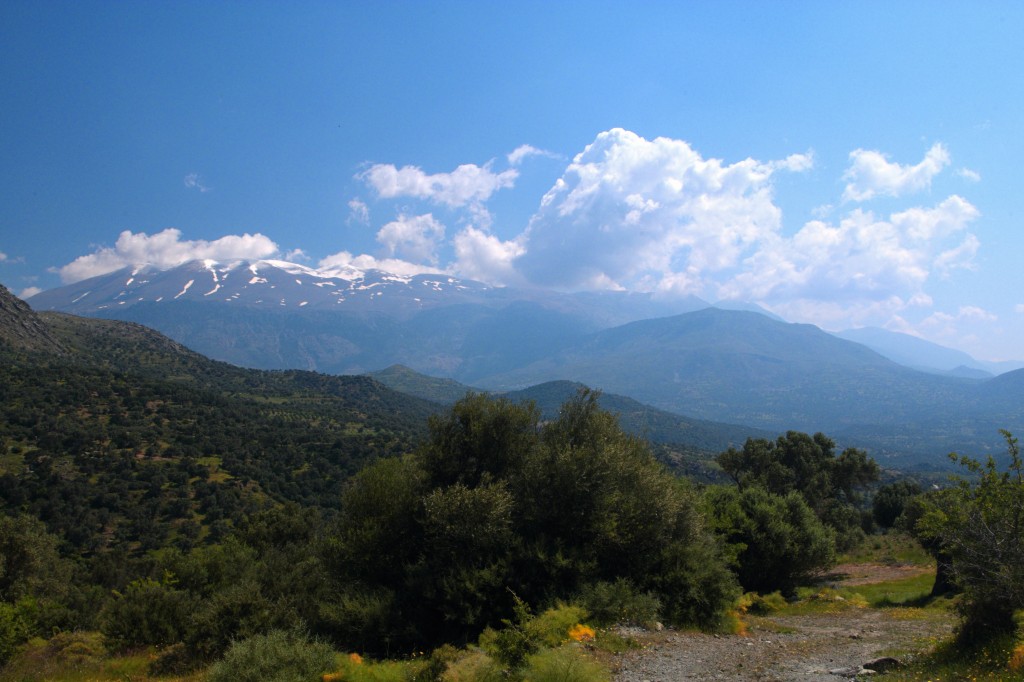 the Greek Titaness Rhea who then placed the infant Zeus in the care of the priesthood of the Curetes (Kuretes). These priests Strabo had written, were also known as the Corybantes, Dactyls, Cabiri, and Telchines which are names that are often used interchangeably with one another. This cave of Zeus sits just above the Plain of Nida on Mount Ida, to the southwest of Knossos. The mother of Zeus was also known in Latin as “Mater Idaea (Idaean Mother).” The name Mount Ida is where the Tribe of Judah had received their name, “the ‘Idaeans,” which is just an earlier spelling of the Judaeans. The reason for this spelling, is because at the time the letter ‘j’ was simply not used.
the Greek Titaness Rhea who then placed the infant Zeus in the care of the priesthood of the Curetes (Kuretes). These priests Strabo had written, were also known as the Corybantes, Dactyls, Cabiri, and Telchines which are names that are often used interchangeably with one another. This cave of Zeus sits just above the Plain of Nida on Mount Ida, to the southwest of Knossos. The mother of Zeus was also known in Latin as “Mater Idaea (Idaean Mother).” The name Mount Ida is where the Tribe of Judah had received their name, “the ‘Idaeans,” which is just an earlier spelling of the Judaeans. The reason for this spelling, is because at the time the letter ‘j’ was simply not used.
The Tribe of Judah is where we get the word Jew which is a derivative of the word Judah, referring to a descendant of the Kingdom of Judah, and a Jew was a word that the Romans had used in propaganda to apply to the followers of the old religions and pagan rites of their ancestors that had conflicted with the state approved Roman religion. The Biblical Judah (in Hebrew: Yehuda) is the original name of the Tribe of Judah, which is traditionally symbolized by a lion. (Wikipedia) In a previous article I had written, The First Jews of Crete, I had detailed some of my research into the Crete, Judaea and Jerusalem connections and where many of the world’s greatest historians call these people from Crete, the Idaeans.
Roman Senator and historian, Cornelius Tacitus (110 A.D.) had written that the Jews often traveled to Crete to celebrate the festival of Pentecost in Jerusalem and that they eventually were exiled from the island when Saturn was driven from his throne by the violence of Jupiter. The Cretans are called Idaeans, and then Judieans who eventually became fugitives from the island and who then settled on the nearest coast of Africa in the remotest corner of Libya. In, The Works of Tacitus, he explains the relationship with Crete, the Jewish people and the exodus from the island of Crete to the coast of Africa in Libya.
The Jews, we are told, escaping from the island of Crete, at the time when Saturn was driven from his throne by the violence of Jupiter, settled in the extreme parts of Libya. Their name is adduced as – a proof. Ida, it is alleged, is a well-known mountain in Crete: the neighboring Idaeans, by an addition to the name to adapt it to the language of barbarians, are ordinarily called Judieans. Some say that the population, overflowing throughout Egypt, in the reign of Isis, was relieved by emigration into the neighboring countries, under the conduct of Hierosolymus and Juda. Many state that they are the progeny of the Ethiopians) who were impelled by fear and detestation to change their abode in the reign of King Cepheus.
The Umbrian connection of Royal Republic of Rome to the Royal Jewish Families of Crete
The reason that I stated in the first paragraph that the Romans were cousins to the Greek Jews from Crete, is because for hundreds of years before the beginning of the Roman Republic Italy was populated by a group of these people. One of these tribes was known as the Umbrians (AKA – Ombrii, Gomerians, Cimmerians, Cymry, Kymry, Cumri, Cumbri, Cimbri, Humbri, and the Celtic people) who had settled in the Tuscany area of Italy, approximately 1,500-500 years before the building of Rome. The Umbrians who historians, Dionysius, Pliny, Florus, and others have written that they were the most ancient people of Italy. Pliny had said “the Greeks had called them the people of the thunderstorm because they “survived the deluge.” This would be the same tribe that had descended from the royal Jewish families of Crete.
Based on various key marriages of the Umbrians in Rome, some of these chosen Jewish families had sons who had risen to the highest honors in the Roman state. Some of whom would become Rome’s first emperors and who we can easily trace their ancestors to the island of Crete. One of these Italian Umbrians was named Nerva (Latin: Marcus Cocceius Nerva Caesar Augustus; 8 November, 30 AD – 27 January, 98 AD), who became the thirteenth Roman Emperor from 96 to 98. Emperor Nerva was born at Narnia, in Umbria, A.D. 27 according to Eutropius (8, 1), or A.D. 32 according to Dio Cassius (68, 4) and he had family who had come from Crete. Another highly venerated Roman Emperor with connection to the Umbrians and family ties to Crete, would happen to be the same man who would lead the destruction of Jerusalem and the Second Temple on Crete. His name I mentioned above, Roman Emperor Titus who would later become a Saint in the Church.
Here is an old image below of the church companions, Saint Paul and Saint Titus holding the Holy See of Crete in their hands, symbolizing their dual governorship of this region via the Holy Roman and Byzantine Empires.

The grandmother of Titus was Vespasia Polla (also known as Vespasia Pollia, born c. 15 BC, fl 1st century AD) who was a descendant of the Cretans through the Umbrians of Italy. Like Emperor Nerva, she was also from the town of Narnia. Polla’s husband was named Titus Flavius Sabinus and he was a customs official and banker in the province of Asia, where he was honored with statues dedicated “To an Honest Tax-gatherer.” They were the mother and father of the Roman emperor Vespasian, and grandparents to the emperor Domitian. (Wikipedia)
These facts are just the beginning of the strong connections between early Rome and ancient Crete.
Polla’s eldest son was named, Titus Flavius T. f. T. n. Sabinus (AD 8–20 December 69 AD). He served as a legate under Aulus Plautius in Britain, along with his brother, Vespasian. He afterwards governed Moesia for seven years. Her youngest son, Vespasian had served as tribunus militum in Thrace, and was quaestor in Crete and Cyrene. A quaestor was a type of public official in the “cursus honorum” system who supervised the financial affairs of the state and conducted audits. In other words, he collected tribute in the form of taxes from his cousins for the Roman Empire. (Wikipedia)
In addition to these Jewish ties, the grandson of Vespasia Polla, Saint Titus had also had a controversial relationship with the Jewish queen Berenice. Berenice was a member of the Herodian Dynasty that ruled the Roman province of Judaea from the island of Crete between 39 BC and 92 AD. As I mentioned above, Crete was part of Judaea, and based on archaeological evidence and many historians, it was also home to the main city or cities that had governed this entire region with their Navy. Berenice was the daughter of King Herod Agrippa I and a sister of King Herod Agrippa II.
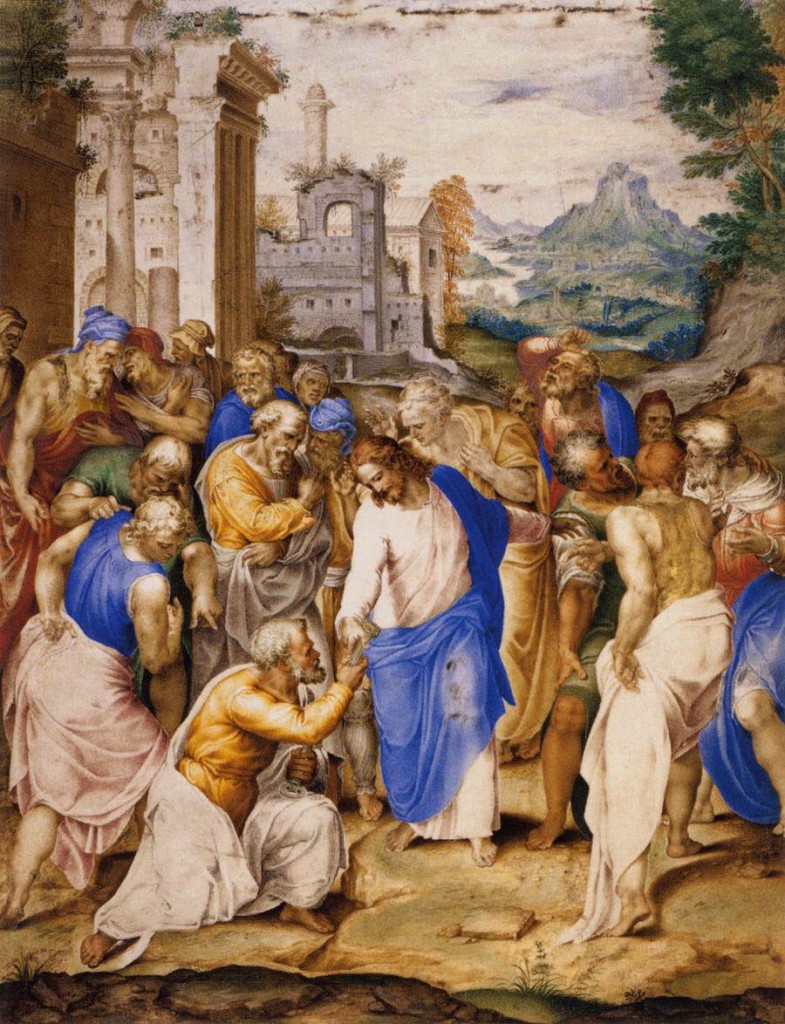 Berenice was also a client ruler of the parts of the Roman Empire, which is said to be modern-day Syria. The family court of Berenice was at Caesarea in Cappadocia and the city was named in honor of Augustus Caesar. Cappadocia is Latin for Crete, and most history surrounding the city of Augustus, Caesarea will often state that this city is in the province of Cappadocia. Caesarea is the precise location or near where it is written Saint Longinus, the Roman soldier pierced Jesus Christ in his side with a lance, the “Holy Lance.” Saint Longinus was said to have been baptized by the apostles of Crete, where he then became a monk who had converted many people to Christianity on the island, and he was eventually martyred under Octavius Augustus Caesar.
Berenice was also a client ruler of the parts of the Roman Empire, which is said to be modern-day Syria. The family court of Berenice was at Caesarea in Cappadocia and the city was named in honor of Augustus Caesar. Cappadocia is Latin for Crete, and most history surrounding the city of Augustus, Caesarea will often state that this city is in the province of Cappadocia. Caesarea is the precise location or near where it is written Saint Longinus, the Roman soldier pierced Jesus Christ in his side with a lance, the “Holy Lance.” Saint Longinus was said to have been baptized by the apostles of Crete, where he then became a monk who had converted many people to Christianity on the island, and he was eventually martyred under Octavius Augustus Caesar.
According to the Acts of the Apostles, Caesarea was first introduced to Christianity when Peter the apostle baptized Cornelius the Centurion, his household, and his soldiers. (Wikipedia) It is also the birthplace of Saint Basil the Elder and the grandmother of Saint Basil the Great, Saint Macrina the Elder and St. Basil the Great, Bishop of Caesarea and Doctor of the Church was born and served the church in Crete.
Caesarea from this point forward was the seat of the Roman prefect and “administrative capital” of the region beginning in 6 A.D. In the Acts of the Apostles, records that during this time, in 60, Paul of Tarsus appeared before this family court at Caesarea. (Wikipedia) Paul or Saul of Tarsus in no other than Paul the Apostle or Saint Paul who had lived on the beautiful island of Crete for two years. Paul is considered one of the most important apostles of our age and he had also founded several churches in Asia Minor and Europe.
My research shows that the main battle in this war was fought on and/or surrounding this very island. It was after the destruction of the Second Temple and Palaces in 70 A.D., that some of the Jewish Cretan kings and families of ancient Greece would become tributaries to Rome where they would still maintain part of their royal status, but more along the lines of Dukes and Templars from this point forward. With this new structure of government, this city and their plan had rose again into a much greater power than before and that still lasts to this very day.
After all, at the time, there was not one place in the world that had so many Greek Jews and royal Jewish families, as there was on this island of Crete. The 1st century Jewish-Roman Historian, Flavius Josephus had married a woman from a royal family on Crete who became his 4th wife and bore him two sons. Roman Emperor Titus would Siege Jerusalem and then destroy the Second Temple in Crete in the First Jewish-Roman War. For winning this war, from this point forward, he would become St. Titus the Apostle, an early Christian leader, and a companion of Saint Paul.
Therefor, it only makes perfect sense to reason that this island of Crete which is named after the Greek word for creation, Kri-ti is the birthplace to the first Gnostic Cities that gave the world many new inventions. This island would also be the stronghold of the ancient Jews who would at one time be formidable foes to Rome and then later would join them as allies under the banner of Christianity via the Universal Church, that we know today as the Catholic Church of the both the Roman and Byzantine Empires (Greece and Russia) with the Orthodox Church under the symbol of the Double Headed Eagle.
“The Lion of the Tribe of Judah has conquered.”
SOURCES:
All information is linked to in yellow and or is open source information from non-copyrighted material that can be easily verified via the internet search engines with some work and a lot of Gnosis.





















